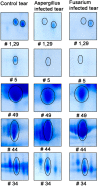Comparative analysis of the tear protein profile in mycotic keratitis patients
- PMID: 18385783
- PMCID: PMC2268856
Comparative analysis of the tear protein profile in mycotic keratitis patients
Abstract
Purpose: Mycotic keratitis is a major cause of corneal blindness in India. A proper understanding of the pathogenesis may help in refining the existing treatment. The purpose of this study is to examine the total tear protein profile of fungal keratitis patients, which may have a bearing on pathogenesis and disease progression.
Methods: Tear samples were collected from culture positive fungal keratitis patients. Tears from the uninfected fellow eye and from other healthy individuals served as controls. Two-dimensional electrophoresis (2DE) was used for the separation of fractionated tear proteins, and selected protein spots, which showed differential expressions, were identified using matrix-assisted laser desorption/ionization-time of flight (MALDI-TOF) mass spectrometry. Wherever needed, tag sequencing of peptide fragments using post source decay (PSD) was done to confirm the identification.
Results: The glutaredoxin-related protein was expressed only in the tears of fungal keratitis patients. Six other normal tear proteins were present in both samples but with varied expression levels. Prolactin inducible protein and serum albumin precursor were upregulated in the infected samples. Cystatin S precursor, cystatin SN precursor, cystatin, and human tear lipocalin were downregulated in the infected samples.
Conclusions: Tears can be used as a clinical source to study the proteomic responses in patients with fungal keratitis. The glutaredoxin-related protein is known to be produced by Aspergillus during oxidative stress conditions, and the presence of this protein in the tears of patients with mycotic keratitis indicates that this pathogen undergoes stress-related gene expression during infection.
Figures


Similar articles
-
Pathogen induced changes in the protein profile of human tears from Fusarium keratitis patients.PLoS One. 2013;8(1):e53018. doi: 10.1371/journal.pone.0053018. Epub 2013 Jan 8. PLoS One. 2013. PMID: 23308132 Free PMC article.
-
Aspergillus flavus induced alterations in tear protein profile reveal pathogen-induced host response to fungal infection.J Proteomics. 2017 Jan 30;152:13-21. doi: 10.1016/j.jprot.2016.10.009. Epub 2016 Oct 24. J Proteomics. 2017. PMID: 27789337
-
Quantitative profiling of tear proteome reveals down regulation of zinc alpha-2 glycoprotein in Aspergillus flavus keratitis patients.Exp Eye Res. 2019 Sep;186:107700. doi: 10.1016/j.exer.2019.107700. Epub 2019 Jun 21. Exp Eye Res. 2019. PMID: 31233730
-
The expanding use of matrix-assisted laser desorption/ionization-time of flight mass spectroscopy in the diagnosis of patients with mycotic diseases.Expert Rev Mol Diagn. 2019 Mar;19(3):241-248. doi: 10.1080/14737159.2019.1574572. Epub 2019 Feb 5. Expert Rev Mol Diagn. 2019. PMID: 30682890 Review.
-
Clinical Tear Fluid Proteomics-A Novel Tool in Glaucoma Research.Int J Mol Sci. 2022 Jul 23;23(15):8136. doi: 10.3390/ijms23158136. Int J Mol Sci. 2022. PMID: 35897711 Free PMC article. Review.
Cited by
-
Cystatin C and lactoferrin concentrations in biological fluids as possible prognostic factors in eye tumor development.Int J Circumpolar Health. 2013 Aug 5;72. doi: 10.3402/ijch.v72i0.21087. eCollection 2013. Int J Circumpolar Health. 2013. PMID: 23984285 Free PMC article.
-
Furosemide and Potassium Chloride-induced Alteration in Protein Profile of Left Ventricle and its Associated Risk for Sudden Cardiac Death.Toxicol Int. 2014 Jan;21(1):1-7. doi: 10.4103/0971-6580.128781. Toxicol Int. 2014. PMID: 24748728 Free PMC article.
-
Precision in Tear Fluid Biomarker Discovery: Quantitative Proteomic Profiling of Small-Volume, Individual Samples Using Capillary Tube Collection.Biomedicines. 2025 Feb 6;13(2):386. doi: 10.3390/biomedicines13020386. Biomedicines. 2025. PMID: 40002800 Free PMC article.
-
A Comprehensive Review of Microbial Biofilms on Contact Lenses: Challenges and Solutions.Infect Drug Resist. 2024 Jun 26;17:2659-2671. doi: 10.2147/IDR.S463779. eCollection 2024. Infect Drug Resist. 2024. PMID: 38947374 Free PMC article. Review.
-
Proteomic Analysis of Larval Integument in a Dominant Obese Translucent (Obs) Silkworm Mutant.J Insect Sci. 2018 Nov 1;18(6):4. doi: 10.1093/jisesa/iey098. J Insect Sci. 2018. PMID: 30412263 Free PMC article.
References
-
- Basak SK, Basak S, Mohanta A, Bhowmick A. Epidemiological and Microbiological diagnosis of suppurative keratitis in Gangetic west Bengal, Eastern India. Indian J Ophthalmol. 2005;53:17–22. - PubMed
-
- Saw SM, Ooi PL, Tan DT, Khor WB, Fong CW, Lim J, Cajucom-Uy HY, Heng D, Chew SK, Aung T. Tan Al, Chan Cl, Ting S, Tambyah PA, Wong TY. Risk Factors for Contact Lens-Related Fusarium Keratitis: A Case-Control Study in Singapore. Arch Ophthalmol. 2007;125:611–7. - PubMed
-
- Iyer SA, Tuli SS, Wagoner RC. Fungal keratitis: emerging trends and treatment outcomes. Eye Contact Lens. 2006;32:267–71. - PubMed
-
- Chang DC, Grant GB, O'Donnell K, Wannemuehler KA, Noble-Wang J, Rao CY, Jacobson LM, Crowell CS, Sneed RS, Lewis FM, Schaffzin JK, Kainer MA, Genese CA, Alfonso EC, Jones DB, Srinivasan A, Fridkin SK, Park BJ, Fusarium Keratitis Investigation Team. Multistate outbreak of Fusarium keratitis associated with use of a contact lens solution. JAMA. 2006;296:953–63. - PubMed
-
- Khor WB, Aung T, Saw SM, Wong TY, Tambyah PA, Tan AL, Beuerman R, Lim L, Chan WK, Heng WJ, Lim J, Loh RS, Lee SB, Tan DT. An outbreak of Fusarium keratitis associated with contact lens wear in Singapore. JAMA. 2006;295:2867–73. - PubMed
Publication types
MeSH terms
Substances
LinkOut - more resources
Full Text Sources
Medical
